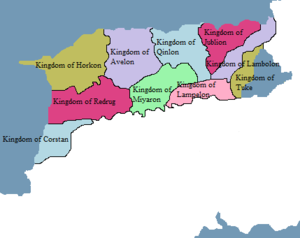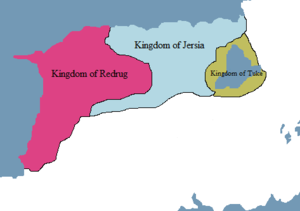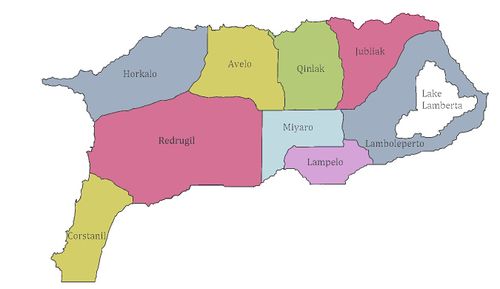Difference between revisions of "Staynes"
(→Predecessor Kingdoms) |
|||
| Line 98: | Line 98: | ||
From the years 765 BC and 650 BC, nothing happened between the three kingdoms. In 650 BC, the kingdoms of Redrug and Jersia became the second Kingdom of Maltervenia after the marriage of king Redunnia II of Redrug and queen Serenia of Jersia. | From the years 765 BC and 650 BC, nothing happened between the three kingdoms. In 650 BC, the kingdoms of Redrug and Jersia became the second Kingdom of Maltervenia after the marriage of king Redunnia II of Redrug and queen Serenia of Jersia. | ||
====Second Kingdom of Maltervenia==== | ====Second Kingdom of Maltervenia==== | ||
| − | After the eventual death of Redunnia II and Serenia, their son, Lampedris I was crowned the first king of the new country. The country existed until its collapse in 452 AD. | + | After the eventual death of Redunnia II and Serenia, their son, Lampedris I was crowned the first king of the new country. The country existed until its collapse in 452 AD, taking over more land until it clashed with the borders of the Kormistazmic Empire, the Xagrurgian Empire and the Ethalrian Empire. |
====Second Integrum Period==== | ====Second Integrum Period==== | ||
| + | |||
| + | In 452 AD, the land was restructured into several hundred tiny states. In the next ten years, and with a lot of wars, the land was reduced to ten states, with significant advances into the original Second Kingdom of Maltervenia by the Kormistazmic Empire and the Ethalrian Empire. | ||
| + | |||
| + | The second integrum lasted until 972 AD, where the Kingdom of Staynnica and the Kingdom of Sztahynz unified to form the Kingdom of Staynes. | ||
| + | |||
====Kingdom of Staynnia==== | ====Kingdom of Staynnia==== | ||
| + | |||
| + | The Kingdom of Staynnica was the far superior Kingdom in the latter stages of the second integrum period. It controlled all of the north and west coasts, but did not have control of the land between the current borders of Staynes, Caltharus and Vothetria. The second, less known Kingdom was Sztahynz, and controlled the eastern land of Lake Lamberta, all the way down to Kirdintayos. | ||
| + | |||
==Politics== | ==Politics== | ||
[[Image:STAYNES MAP STATES.jpg|left|thumb|500px||Map of Mainland Staynes showing its nine states.]] | [[Image:STAYNES MAP STATES.jpg|left|thumb|500px||Map of Mainland Staynes showing its nine states.]] | ||
Revision as of 10:33, 13 December 2017
| This page is a work in progress by its author(s) and should not be considered final. |
| Staynes | ||||||
|---|---|---|---|---|---|---|
|
||||||
| Motto: In the depths of winter will you find sanative. | ||||||
| Anthem: "Rise the Empire through Union." | ||||||
| Capital and largest city | Sani Bursil | |||||
| Official languages | Staynish Old Staynic |
|||||
| Recognised regional languages | Horkalese New Axdelian Calth |
|||||
| Ethnic groups (2016) | 98.7% Human 1.2% Feline 0.1% unspecified |
|||||
| Demonym | Staynes, Staynish, Staynic (rare) | |||||
| Government | Part of a constitutional monarchy | |||||
| - | Monarch | Lambertus VII | ||||
| Legislature | Parliament of the United Kingdom | |||||
| Establishment | ||||||
| - | Union of the Thrones under Lambertus III | 29 Dec 1515 | ||||
| - | Ascendancy of the Morstaybishlian Empire over the Kormistazmic Empire | 1575 | ||||
| - | Secession of South Staynes | 6 Jun 1975 | ||||
| - | Acts of Union of Staynes and Justelvard | 16 Dec 2016 | ||||
| Population | ||||||
| - | 2017 estimate | 148,800,942 | ||||
| - | 2013 census | 143,321,894 | ||||
| - | Density | (n/a)/km2 (n/a)/sq mi |
||||
| Gini (2014) | 3.8 low |
|||||
| HDI ((n/a)) | 0.8 high |
|||||
| Currency | Kirib (♅) |
|||||
| Date format | DD/MM/YYYY | |||||
| Drives on the | the left | |||||
| ISO 3166 code | STA | |||||
| Internet TLD | .sta | |||||
(Page undergoing heavy revision)
Staynes and sometimes North Staynes since the independence of South Staynes is a country in the United Kingdom. It shares land borders with South Staynes and Xagrurg to its south, Caltharus to the east, Axdel to the west and Vothetria to the south-east.
The area now called Staynes was first inhabited by modern humans known as the Strathipolic people around 52,000 years ago, but takes its name from the Staynnia, the most prosperous kingdom during the time where the second kingdom of Maltervenia fell and the "third" kingdom of Maltervenia (Kingdom of Staynes) rose. Staynes became a unified state in the 10th century, and since the Age of Discovery, which began during the 15th century, has had a significant cultural and legal impact on the wider world. The Staynish language, the Juliakese Church, and Staynish law – the basis for the common law legal systems of many other countries around the world – developed in Staynes, and the country's parliamentary system of government has been adopted by a respectable count of other nations.
Staynes' terrain mostly comprises low hills and plains, especially in central and western Staynes. However, there are uplands in the south (for example, the Zycannes and the mountainous Petenta District) and in the southwest (Zycannes). The capital is Sani Bursil, which has the largest metropolitan area in both the United Kingdom and the world. Staynes' population of over 148 million comprises 32.8% of the population of the United Kingdom, largely concentrated around Sani Bursil, the West Coast, and conurbations in the Midlands, the Far North East, and Horkalo, which each developed as major industrial regions during the 19th century.
The Kingdom of Staynes ceased being a separate sovereign state on the 29th of December 1515, when the Union of the Thrones merged the two thrones under one name, resulting in a political union with the Kingdom of Caltharus to create the Kingdom of Morstaybishlia. As a result of the Auroran Imperial War, on the 6th of June 1975, South Staynes seceded from the Kingdom.
Staynes is a developed country and is considered to have a high-income economy and is categorised as high in the Human Development Index. There is a total GDP per capita of $40,597 in Staynes and its dependencies, which is rich. Staynes has remained as a highly influential core country especially influencing events in Aurora. It is a recognised nuclear weapons state.
Contents
History
Last Interglacial period
Between fifty two and thirty thousand years ago, seventy percent of Staynes was underwater. The interglacial period marked sea levels as high as 46 meters. The sea resembled the shape of a deflated balloon, connecting Lake Lamberta to the western coast. Around 50,000 BC, the Strathepolic people reach the continent as the Strathepolic Ridge submerged (ridge connecting modern Justelvard to the modern Staynish-Caltharus border). A few hundred years later they began to explore the continent beyond the reaches of their local settlements. By 49,000 BC, there was three very distinct divides in the Strathepolic people; Jubrites, Maltites and Kosites. The Jubrites had settled within the Jubrione, the Maltites had settled in and around the Zycannes and the Kosites had migrated eastwards.
To date, Lake Lamberta is one of the last remnants of the last interglacial period. Its one of the largest salt water bodies in the world.
Predecessor Kingdoms
First Kingdom of Maltervenia
Maltervenian culture is believed to have been its own culture as early as 35,000 BC, whilst still distinct to the Strathepolic culture. It is believed this culture refined itself as early as 10,000 BC, becoming one of a few successors to the extinct Strathepolic culture. Within the 5th millennium BC, numerous kinship groups emerged. In the very first years of the 2nd millennium BC, the first kingdom of Maltervenia formed. The kingdom was ruled by the Jubrita dynasty for three hundred years until it was taken over by the Bagrin dynasty. Their dynasty thrived on slaves from across the continent, building ancient temples, castles and their footprint across the lands for another seven hundred years until the death of its last king.
Integrum period
Upon king Volkemur's death in 998 BC, the kingdom of Maltervenia split into ten smaller kingdoms. The names for these kingdoms were Horkon, Avelon, Qinlon, Jublon, Redrug, Miyaron, Lampelon, Corstan, Lambolon and Tuke.
From 998 BC to 765 BC, the ten kingdoms had become three after several marriages for geopolitical benefits; the Kingdom of Redrug, the Kingdom of Jersia and the Kingdom of Tuke. In 972 BC, the kingdoms of Qinlon and Avelon became the kingdom of Qinlia-Avelon after the marriage of king Lutder of Qinlon and queen Nasama of Avelon. In 901 BC, the kingdom of Redrug fought and won against the kingdom of Corstan, taking control over the area. In 863 BC, the kingdoms of Jublion and Lambolon became the kingdom of Jubliak-Lambolon after the marriage of king Pippindu and of Jubliak and queen Bourna of Lambolon. Around 800 BC, the kingdom of Redrug fought and won against the kingdom of Horkon, taking control over the area. In 795 BC, the kingdom of Jubliak-Lambolon declared war against the kingdom of Miyaron. During the conflict, Miyaron allied itself with Lampelon, creating a capable resistance to the stronger eastern country. In 789 BC, the kingdom of Jubliak-Lambolon and the kingdom of Qinlia-Avelon became the United Kingdom of Jubliak-Lambolon and Qinlia-Avelon after the marriage of king Norgel of Qinlia-Avelon and queen Vessala of Jubliak-Lambolon. After the United Kingdom defeated the kingdoms of Miyaron and Lampelon in 765 BC, taking control over the area; the united kingdom of Jubliak-Lambolon and Qinlia-Avelon became the kingdom of Jersia.
From the years 765 BC and 650 BC, nothing happened between the three kingdoms. In 650 BC, the kingdoms of Redrug and Jersia became the second Kingdom of Maltervenia after the marriage of king Redunnia II of Redrug and queen Serenia of Jersia.
Second Kingdom of Maltervenia
After the eventual death of Redunnia II and Serenia, their son, Lampedris I was crowned the first king of the new country. The country existed until its collapse in 452 AD, taking over more land until it clashed with the borders of the Kormistazmic Empire, the Xagrurgian Empire and the Ethalrian Empire.
Second Integrum Period
In 452 AD, the land was restructured into several hundred tiny states. In the next ten years, and with a lot of wars, the land was reduced to ten states, with significant advances into the original Second Kingdom of Maltervenia by the Kormistazmic Empire and the Ethalrian Empire.
The second integrum lasted until 972 AD, where the Kingdom of Staynnica and the Kingdom of Sztahynz unified to form the Kingdom of Staynes.
Kingdom of Staynnia
The Kingdom of Staynnica was the far superior Kingdom in the latter stages of the second integrum period. It controlled all of the north and west coasts, but did not have control of the land between the current borders of Staynes, Caltharus and Vothetria. The second, less known Kingdom was Sztahynz, and controlled the eastern land of Lake Lamberta, all the way down to Kirdintayos.





